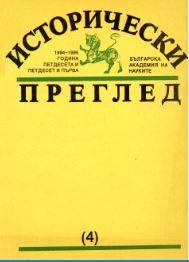Етнически състав на населението и демографски промени във Филипопол (IV–XIV в.)
Ethnic Composition of the Population and Demographic Changes in Philippopolis (4th – 14th c.)
Author(s): Annie Dancheva-VasilevaSubject(s): History, Ethnohistory, Ancient World, Middle Ages, 6th to 12th Centuries, 13th to 14th Centuries
Published by: Институт за исторически изследвания - Българска академия на науките
Summary/Abstract: The ethnic picture in Philippopolis in Late Antiquity and the Early Byzantine Epoch showed a relative stability of the Thracian ethnic substrate, the presence of immigrants from the Asian provinces, a Hellenized urban population and relatively weak penetration of barbarians. There are no convincing data on the penetration of Slavs in the citadel of the city and the level space next to it unlike the environs of the city. In the 5th – 6th c. according to an archaeological monument there was a Jewish community in Philippopolis. In the 8th c. the imperial authorities carried out mass resettlements of American and other Asian population in Philippopolis and its outskirts which continued in the following centuries to result in the 12th and 13th c. in a considerably numerous Armenian community. The first mass Bulgarian penetration in Philippopolis is referred to 836 when it was seized by Khan Malamir. During the reign of King Simeon this presence certainly consolidated. Particularly favourable conditions for the penetration and settlement of Bulgarians in Philippopolis were created after the fall of Bulgaria under Byzantine rule. This transpires from the sources referring to the early 13th c. and attesting to a considerable Bulgarian population in the city. During the centuries indicated, all the cities of the Empire suffered the invasions by Uzes, Cumans and Pecheneges, while Philippopolis in particular endured the passing of the first three Crusades. In the city emerged quarters on ethnic differentiation: Latin, Armenian, probably a Bulgarian, etc. During the wars of King Simeon and King Kaloyan the population of Philippopolis passed through major demographic perturbations. In the 13th and 14th c. the Bulgarian population in the city became one of the largest ethnic groups and the opinion may be expressed that it was not only equal to the Greek in size but in the second half of the 14th c. it became even predominant. Throughout the Middle Ages Philippopolis was a variegated ethnic centre, and it has preserved this character up to now.
Journal: Исторически преглед
- Issue Year: 1995
- Issue No: 4
- Page Range: 3-24
- Page Count: 22
- Language: Bulgarian
- Content File-PDF

